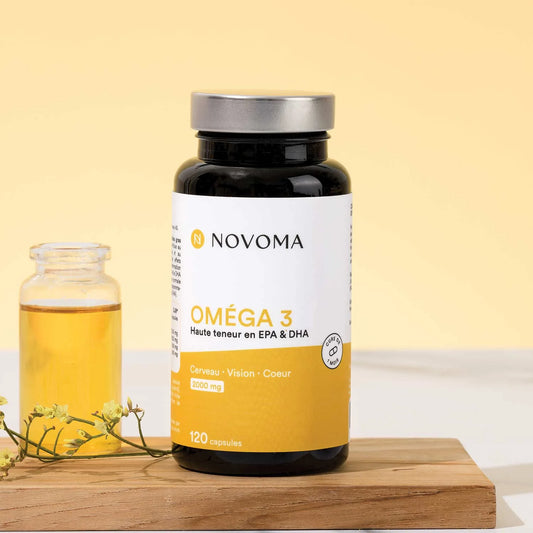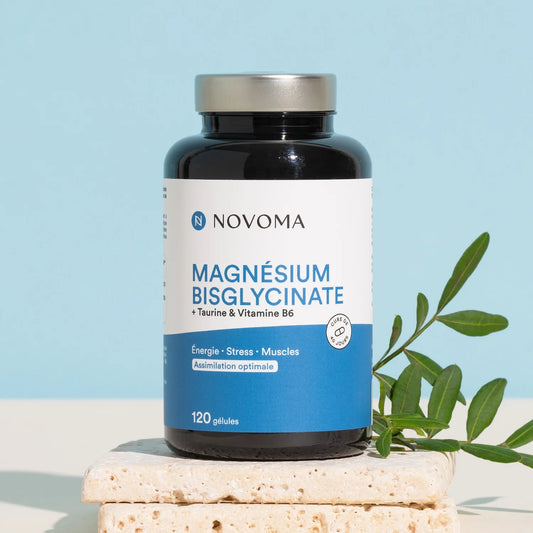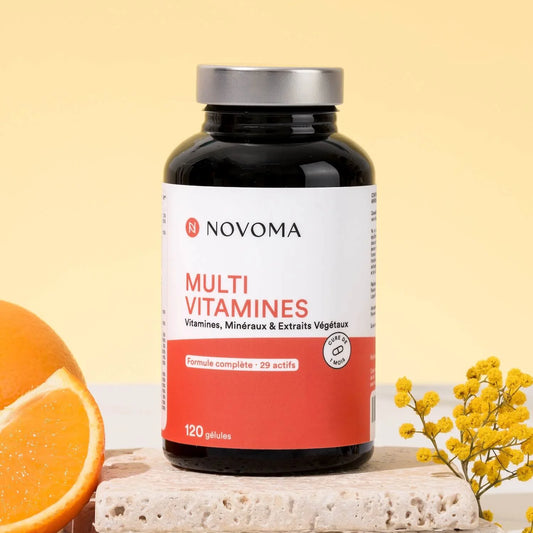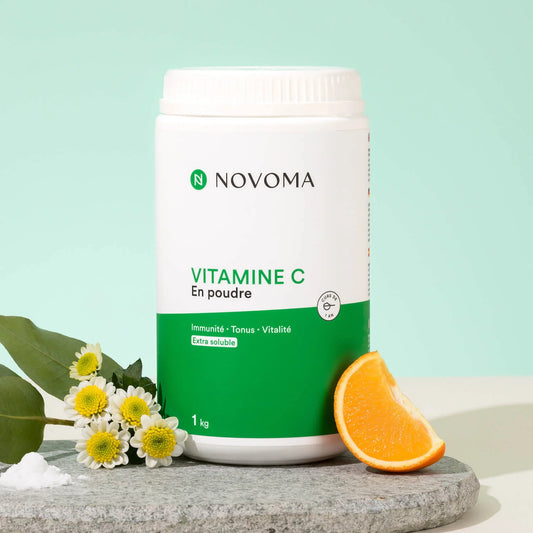
What is the Best Omega 3? Our Advice and Opinions (2024)
Omega 3s are essential fatty acids that play a crucial role in heart, brain and joint function. Unfortunately, most people don't get enough omega 3 in their daily diet. This Anses study , for example, tells us (p. 30 of the report) that 89% of adults in France are at risk of lacking EPA and DHA, polyunsaturated fatty acids good for the body – the famous “good fat " !
Fortunately, many sources of omega 3 are available. Oily fish like salmon, tuna, sardines and herring are rich sources of omega 3 EPA and DHA. Fish oils, nuts, seeds and legumes like flax seeds, chia seeds and hemp seeds are also sources of quality Omega 3 ALA.
But how do you know which omega 3 is best for you? The benefits and properties of different sources vary. We explain everything to you in this detailed guide.

Omega 3: essential fatty acids for our body
Omega 3s are essential fatty acids that play an important role in heart, brain and joint functions. Omega 3s are divided into three types: eicosapentaenoic acid (EPA), docosahexaenoic acid (DHA) and alpha-linolenic acid (ALA). The first two are mainly found in fatty fish and fish oils, the latter in nuts, seeds and legumes.
The benefits of omega 3 are numerous. They contribute to heart function, brain function, cognitive functions, and are beneficial to joints. Omega 3 also contributes to the appearance of the skin.
Be careful though : it is important to maintain a good balance between omega 3 and omega 6 in our diet. Getting enough omega 3 can help balance omega 6 levels.
To find out more about omega 3, their types and their distribution, you can discover our complete guide to omega 3 .
Fatty fish, oils, nuts, seeds: what are the best sources of omega 3?
There are many sources of omega 3, each with their own benefits. Oily fish 🐟 like salmon, tuna, sardines and herring are rich sources of omega 3 EPA and DHA. These two fatty acids are particularly beneficial for heart function. However, be careful to eat fatty fish from sustainable sources, monitoring the origin and method of fishing.
Fish oils , such as krill oil or salmon oil, are also a rich source of omega 3 EPA and DHA. They are often used in the form of dietary supplements and can be a good option for people who struggle to get enough oily fish in their diet... which is a lot of us!
Nuts, seeds and legumes like flax seeds , chia seeds and hemp seeds are sources of omega 3 ALA. ALA benefits the brain and eyes. Flaxseeds are particularly rich in ALA and can be used in powder form or pressed to make oil.

EPA, DHA and ALA, the best fatty acids for your body
Okay, we've already mentioned EPA, DHA and ALA several times, but... what exactly are they?
As we have said, these are the 3 main types of omega 3. All are fatty acids.
A fatty acid is an organic molecule composed of carbon and hydrogen chains. Fatty acids play an important role in our body: they are used for energy production, building cells, and are also involved in many metabolic processes. Some fatty acids are considered essential, meaning our body cannot produce them itself and must therefore obtain them from food. Omega 3 fatty acids are one of them.
EPA (eicosapentaenoic acid) is a polyunsaturated fatty acid. It is particularly useful for the heart and for mood.
DHA (docosahexaenoic acid) is another omega 3 fatty acid that is essential for normal brain function. It is also important for the eyes and for the development and growth of fetuses and young children.
ALA (alpha-linolenic acid) is an omega 3 fatty acid found primarily in plants such as flaxseeds, walnuts and chia seeds.
ALA is not the best omega 3 because it is less easily used by the body. But for all that, it is better to have a balanced consumption of the different types of omega 3 fatty acids to benefit as much as possible from their benefits for the body!
We recommend you
Omega 3
Ultra pure fish oil concentrated in essential omega 3 fatty acids (90% triglycerides).
- ✅ Ultra pure EPAX® fish oil
- ✅ 800 mg EPA & 600 mg DHA
- ✅ Friend of the Sea®
- ✅ Minimal oxidation (Totox < 3)
How to choose the best omega 3 supplement? Our advices.
When choosing an omega 3 supplement, there are several important factors to consider. Here are some tips and tricks to help you choose the best omega 3 for your body.
The origin of Omega 3
Find out where the omega 3 you consume comes from.
Omega 3 can be of plant or animal origin.
More concretely :
- - Plant sources of omega 3 generally include algae, flax seeds and nuts. The benefits of consuming plant-based omega 3 are that these sources are often rich in other nutrients such as fiber, antioxidants and vitamins. Additionally, plant-based omega 3s are considered a more ethical and sustainable option because their production does not require killing animals. They are therefore suitable for people following a vegan diet. However, plant-based omega 3s are often less concentrated in EPA and DHA, and are often more expensive.
- - Animal sources of omega 3 include fatty fish such as salmon, tuna, sardines and mackerel, as well as fish oils. The benefits of consuming animal-based omega 3s are that they are often higher in EPA and DHA, the most health-promoting types of omega 3 fatty acids. However, it is important to choose sources of fish that are sustainable by favoring eco-responsible fishing which is recognized thanks to certain labels such as the Friend of the Sea® label , which certifies fishing that respects biodiversity. In addition, it is important to favor small wild fish, which contain fewer heavy metals and contaminants.
The composition and content of omega 3
The concentration of EPA, DHA and ALA varies from one supplement to another, so you should check the composition before making your choice.
Additionally, it is important to note that when choosing an omega 3 supplement, it is best to focus on the percentage of EPA and DHA rather than the milligram content. At Novoma, our Epax fish oil has a high ratio of 40% EPA and 30% DHA, which is perfectly balanced. This is important because on the market there are many food supplements with a zero or unbalanced ratio. ANSES recommends a minimum of 500 mg of EPA and DHA combined; our omega 3 food supplement , for example, contains 800 mg of EPA and 600 mg of DHA per dose, quantities that are both optimal and perfectly balanced 💪
We recommend you
Omega 3
Ultra pure fish oil concentrated in essential omega 3 fatty acids (90% triglycerides).
- ✅ Ultra pure EPAX® fish oil
- ✅ 800 mg EPA & 600 mg DHA
- ✅ Friend of the Sea®
- ✅ Minimal oxidation (Totox < 3)
Certifications and labels
Certifications and labels guarantee the quality and purity of the products. One of the most recognized in the world is the Epax® label.
Epax® fish oil is extracted at low temperatures and then cleaned in Aalesund, Norway. A patented molecular distillation method is used to purify the oil, which removes all environmental contaminants and heavy metals. The purity of the oil exceeds the standards set by GOED.
The advantage of Epax fish oil is that it is ultra concentrated in omega 3 in the natural form of triglycerides, which is easily bioavailable to the body. It offers an excellent balance of fatty acids, with 40% EPA and 30% DHA.
Oxidation
Make sure your supplements are pure and non-oxidized. Indeed, oxidation is a normal process in all fats and oils following the presence of unsaturated fatty acids.
There is a crucial index for measuring the rate of omega 3 oxidation: TOTOX. The lower the index, the less oxidized or rancid the oil is, meaning the omega 3s in the oil are less likely to be destroyed. It is therefore essential to check this index before purchasing omega 3. The maximum recommended limit is 26.
At Novoma, we are proud to announce that the TOTOX of our omega 3 remains below 3 throughout the life of our product. This very low figure guarantees that each capsule contains a maximum amount of omega 3. This is made possible thanks to the stabilization of our fish oil by a patented method (called XO®) in order to preserve its nutritional and organoleptic qualities. This process uses natural antioxidants such as rosemary extracts and tocopherols to ensure exceptional stability of polyunsaturated fatty acids.

The brand
Brand transparency is also important when choosing the best omega 3. It is always welcome to inquire about the brand's values and check that it provides certificates of analysis to guarantee the quality of its products.
The price
Of course, price is also a factor to consider when choosing an omega 3 supplement. Make sure the product you buy is worth it in terms of quality and dosage.
Capsules, gummies or liquid: what is the best form of omega 3 for you?
There are several forms of omega 3 supplements on the market, each with their own advantages and disadvantages. Here's an overview of the different shapes available and who they are best suited for.
- - Omega 3 capsules are probably the most popular and convenient form of consuming omega 3-rich fish oil. They offer many benefits including being easy to swallow and being easy to swallow. can be taken anywhere, at any time of the day. In addition, with quality fish oil, capsules generally prevent a fishy aftertaste in the mouth. Note that the capsules may be difficult to swallow for some people, particularly children or people who have difficulty swallowing tablets. There are mainly 2 capsule sizes: 500 mg or 1000 mg. For greater ease and a more pleasant mouth experience, at Novoma we prefer 500 mg capsules.
- - Omega 3 gummies are a newer form of supplement. They usually have a pleasant flavor and are more easily consumed by children. However, they tend to be less concentrated in EPA and DHA than capsules, since they only contain omega 3 extracted from algae. This explains why they are not very common on the market and also not very concentrated in fatty acids. As a result, they may be less effective for some people who need a higher dose of EPA and DHA. To learn more about gummies, we invite you to consult our blog article on gummies .
- - Liquid forms of omega 3 are an easy-to-take alternative for people who have difficulty swallowing capsules. They can easily be mixed with food or drinks and are easily absorbed by the body. The downside: they can be quite expensive, and have a strong flavor that not everyone likes!
The best omega 3 to the rescue of your shape!
You have understood, omega 3 is an essential fatty acid for our well-being , both cardiac and cerebral. ANSES therefore recommends a daily consumption of 250 mg (each) of EPA and DHA , and 1% of caloric intake of ALA. These omega 3 fatty acids EPA, DHA and ALA have unique properties, and are mainly found in fatty fish, oils, seeds and legumes.
Unfortunately, these foods are often absent from our diet, or present too little, and then it is the nutritional deficit that threatens us – or the imbalance between the various types of fatty acids! You must therefore favor omega 3 over omega 6, and for that, if you cannot rely on a good diet, you can use food supplements.
If necessary, we advise you to favor food supplements that are well dosed, traceable, affordable, and sufficiently rich in active ingredients. In this regard, the best form of omega 3 is probably triglycerides , which are the natural lipids used to store fatty acids in the body. This is the form that we have chosen for our EPAX fish oil supplement, for perfect assimilation and balance of fatty acids. 👌




























